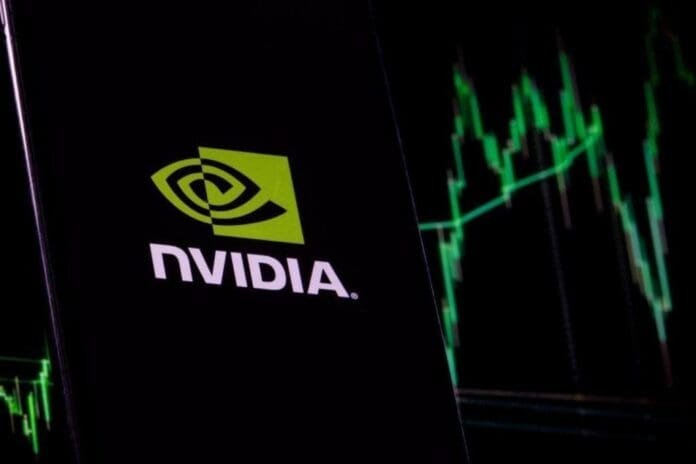Nvidia, a crucial player in the artificial intelligence (AI) boom, had its stock rocket to an all-time high, closing 2.3% higher at $504 on Monday, just ahead of the company’s fiscal third-quarter results on Tuesday. For this quarter, analysts predict impressive sales growth of more than 170%.
There’s more excitement to come. Nvidia’s forecast for the fiscal fourth quarter is expected to show an even more spectacular figure, with about 200% growth, according to estimations from the London Stock Exchange Group (LSEG).
With the exception of all other S&P 500 companies, Nvidia’s stock has surged by an astounding 245% in 2023, and all eyes are on the company as Wall Street prepares for the Thanksgiving holiday.

Nvidia’s upcoming earnings call is highly anticipated, with the market anxious for information into the health of generative AI enthusiasm, customer patterns, and potential implications from China-related restrictions. The company has seen a phenomenal run, but any indication of a slowdown in the frenzy surrounding AI, client shifts to AMD’s chips, or negative consequences from geopolitical restraints all present issues.
In a note last week, Bank of America analysts, who still have a buy recommendation on Nvidia, expressed excitement about the results call, anticipating beats and a possible increase. But, they also emphasized that issues that can draw in investors include worries about China’s limitations and heightened competition.
For Nvidia, which has generally controlled the AI graphics processing unit (GPU) market, the entry of Advanced Micro Devices (AMD) into the generative AI space brings more competition. According to recent announcements made by Lisa Su, CEO of AMD, GPU revenue is expected to reach over $400 million in the fourth quarter and surpass $2 billion in 2024. Competition is expected to increase even more with the release of AMD’s most sophisticated GPU for AI, the MI300X, whose shipments are expected to start this year. Nvidia’s impressive success may encounter difficulties and scrutiny in the upcoming quarters, given the ever-changing AI market scenario.
Nvidia, the undisputed market leader in GPUs for artificial intelligence (AI), is facing difficulties as industry analysts start to focus more and more on the company’s expensive costs.
Analysts at Bank of America have called on Nvidia (NVDA) to take a proactive stance against the belief that its products are too costly for generative AI inference.
Nvidia just unveiled the H200, a state-of-the-art GPU designed for developing and implementing AI models, in an effort to hold onto its hegemony and spur the ongoing explosion of generative AI. The H200, an improved version of the H100, was introduced last week and is intended to drive sophisticated apps like chatbots that can interpret simple text and turn it into creative graphical designs.
According to Raymond James, the H100 chips, which OpenAI used to train its GPT-4 Turbo big language model, are expensive, ranging from $25,000 to $40,000. The generative AI environment is not complete without large-scale models, which require thousands of these chips to operate in tandem during the training process.
Nvidia’s data center segment, which houses the H100 processors, saw revenue jump 171% to $10.32 billion in the fiscal second quarter, accounting for roughly three-quarters of the company’s total revenue.
According to FactSet, analysts forecast a significant increase in data center growth for the fiscal third quarter, with the sector almost quadrupling to $13.02 billion from $3.83 billion the year before. According to analysts surveyed by LSEG (previously Refinitiv), overall revenue is expected to increase by 172% to $16.2 billion over the same period. According to LSEG forecasts, growth is expected to reach a peak of over 195% in the fiscal fourth quarter and then continue steadily, albeit at a slower rate each quarter, through 2024.

Investors are probably looking for answers regarding the recent turmoil at OpenAI, which has been a significant driver of Nvidia’s growth, as the company approaches its earnings call. The industry has been affected by the abrupt dismissal of CEO Sam Altman due to differences in the company’s direction and pace of product development. Former Twitch CEO Emmett Shear has been named temporary CEO, while Altman will join Microsoft to head a new advanced AI research team, together with Greg Brockman, the chairman of OpenAI, who was fired.
Investors in Nvidia have persevered despite worries about China. The prior year, U.S. restrictions that sought to restrict sales to China had an impact on the H100 and A100 AI chips. Some concerns have been allayed by Nvidia’s promise in September 2022 that the U.S. government approve the development of H100 in China, which accounts for 20% to 25% of its data center business.
Due to high investor interest this year, Nvidia, which is renowned for its cautious approach to yearly projections, is being closely watched. Amid the thriving generative AI landscape, analysts and investors are eagerly anticipating CEO Jensen Huang’s statements during the conference call, hoping to gain some insight into the company’s strategy. Given the significant investments made in Nvidia this year, investors will be watching for any signs of a reversal in the enthusiasm surrounding generative AI.




